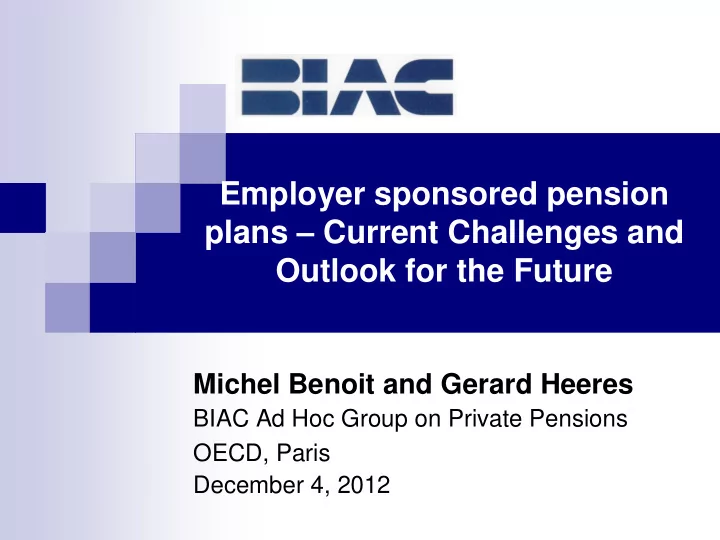

Employer sponsored pension plans – Current Challenges and Outlook for the Future Michel Benoit and Gerard Heeres BIAC Ad Hoc Group on Private Pensions OECD, Paris December 4, 2012
Presentation by Michel Benoit
BIAC Presentation of December 3, 2007 Pension policy must promote employer sponsored pension plans, ensure delivery of the pension promise and balance the interests of all stakeholders Regulation of Funding and Design of DB plans must provide flexibility Sponsors operate in a highly competitive and often multi jurisdiction environment with limited resources available to administer complex pension arrangements
BIAC Presentation of December 3, 2007 Funding volatility and overly restrictive regulation will lead employers to re-assess the sustainability of defined benefit pension plans Growing concern by employers over the impact of proposed changes to accounting rules on defined benefit pension plans Without significant improvement in the regulatory and accounting environment the decline of DB Plans will accelerate with a corresponding increase in DC Plans
What happened between 2007 and 2012? 2008: Worldwide financial meltdown 2009-2011: temporary pension funding relief measures for DB plans provided by governments Worldwide review of financial sector regulation (banks, insurance companies) Historically low yields on long term government bonds in countries with strong economies coupled with downgrading of sovereign debt for many countries
What happened between 2007 and 2012? Continued implementation of IAS 19 (effective as of 01.01.2005) by IASB with clear preference for DC arrangements Continued and accelerated decline of DB plans Legacy issues for plans with long service employees and important retiree cohorts Improved longevity exacerbating longevity risk and associated costs
What happened between 2007 and 2012? Growing acknowledgement that DC Plans are not the best alternative to DB plans shortcomings Focus on de-risking and risk management Redefinition of the “pension promise”: risk sharing of the pension promise is increasingly perceived to be the answer to the continued uncertainty of the long-term financial environment (e.g. recent settlements in US and Canada between Unions and GM, Chrysler and Ford)
Presentation by Gerard Heeres
Two issues are of particular concern for DB Plans in Europe Revised International Accounting Standard 19 (IAS 19R) Revision of Institutions Occupational Retirement Provision (IORP) Directive 2003
International Accounting Standard 19 Mandatory compliance for entities listed on recognized exchanges Pension fund assets/liabilities to be reflected on the balance sheet of the sponsoring entity Plans with Fixed contributions No risk for the entity are the only plans considered as DC ; all other plans are DB
International Accounting Standard 19R, June 2012 Effective as of financial year 2012/2013 Plans to be considered DC only if actuarial and investment risks rest in substance with the employee All other plans classified as DB; as a result both risks rest with the employer Risk-sharing and shared-funding in Defined Benefit Obligations are recognized Elimination of the "corridor approach “; as a result actuarial and investment gains and losses will be treated as " Other Comprehensive Income "
Consequences for DB-plans More volatility in the balance sheet of the entity Risk of substantial impact on shareholder equity is of paramount importance for the entity Employer financial risk is significantly increased Rethinking / reviewing DB-pension plans and pension design by employers
Revision of Institutions Occupational Retirement Provision (directive 2003) / Solvency 2 Three objectives: Maintain level playing field with Solvency 2 Promote more cross-border activity Help improve overall pension provision in the European Union
Consequences for DB-plans Enhanced capital buffers with ca. 10% Enhanced Defined Benefit Obligations (10%-40% increase), depending on the indexation promise Shorter repair periods Defensive investment policy will dominate with a view of enhancing short term security at the expense of long-term investment and pension adequacy (see Joint statement of 23.10.2012 by ETUC, PensionEurope, BusinessEurope, etc) Rethinking/reviewing DB-pension plans and pension design by employers and employees
Conclusions (presented by Michel Benoit) In 2007 BIAC advised there would be little future for DB plans, unless both accounting rules and solvency regulations were revised to provide more flexibility Unfortunately accounting standards and solvency regulations have been made even more strict and this trend is expected to continue In a nutshell: the outlook for DB-plans is very poor
BIAC’s suggests that pension policy going forward be dictated by the following A better outlook for all types of occupational pension plans (DB, DC, Hybrid, etc) can be provided if all stakeholders agree to a redefinition of the “pension promise” through risk sharing. This would lead to better governance, increased flexibility in funding and accounting rules and improved financial literacy by employees .
Recommend
More recommend